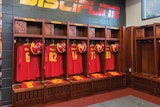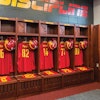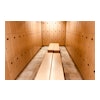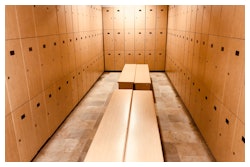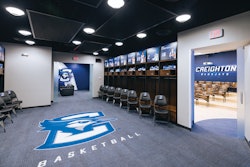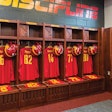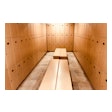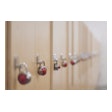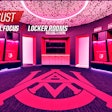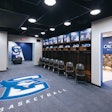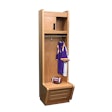With the right planning, locker rooms can shine.
Take notes
Before you start picking out paint colors and light fixtures, visit other fitness centers in your area and around the country, if possible. Let the manager know who you are and why you want to tour the facility. Take a notebook with you, and write down what you like and what you don't about all aspects of the locker rooms. Pay attention to the size, layout and flow of the space. Are there any unusual amenities? Do you like the color scheme? Don't limit yourself to fitness centers that are similar to yours; visit hospitals, rehabilitative facilities, public recreation centers, universities and other places likely to have a locker room. You never know where you may find a creative new idea to use in your own fitness center.
Cater to your market
Think hard about the people who will use your facility. A locker room must be designed with these people in mind. Do you have children's programs? Will the fitness center be busy mainly in the morning, or all day? Will the early morning crowd need to change into pressed suits? Do you have special classes or programs for aquatics, sports or older adults? Then you may need to consider things like special flooring, swimsuit dryers, extra hand rails and wheelchair accessible showers. Think of every person who will use your fitness center, and what their locker room needs will be. Make sure you provide enough room to accommodate a busy morning rush hour, and give each person a degree of personal space and privacy.
Focus groups are a great way to find out what your existing members would like to see in a redesign. They can give you input on everything from carpet colors to hairdryers. You can put up a simple suggestion box, or have a sit-down meeting. For a new facility, you can survey members of the surrounding community. If you have the budget, it's a good idea to have a professional marketing company or your designer run the focus group. They are used to rounding up the right kind of people, and eliciting useful information without wasting time.
Team up
Find a reputable architect and/or interior designer to help you design your locker rooms. Don't just rely on the phone book; get referrals from businesses in your area. If there's an interior you really enjoy, ask the manager what firm was involved. Designers often work on spaces in distant areas, so you may be able to have them consult on your project even if they don't have an office nearby. Discuss your likes and dislikes with the designer, as well as results from your focus group discussions.
What to consider
What goes into a great locker room design? According to Doug Driscoll, project manager and designer with Seibert Architects P.A., Sarasota, Fla., the first consideration is comfort. "A comfortable setting is one that pays attention to materials," Driscoll says. "How you use metals, wood, fabrics, floor finishes and the like can set people at ease or add to their stress level." If you live in a warm climate, for example, the right materials can make members feel cooler. Also, the materials and colors used in the locker rooms should flow into the rest of your fitness center. You don't want a visual shock when walking from one room to another. At Seibert-designed Evolution Health and Fitness in Florida, Driscoll used an abundance of wood throughout the fitness center to give an intimate feeling. The facility also has wood lockers, which are quieter and more inviting than metal ones.
Proper locker room hygiene is, of course, extremely important, so be sure to choose materials that are easy to clean and specifically made for locker room use.
The next consideration is privacy. "You can convey a feeling of privacy by separating areas, pulling them around corners," Driscoll says. "Lockers, showers and lavatory areas should all be separate. These separations should be more dramatic in a ladies' locker room. Women tend to take more time getting prepared; it's a time to socialize with their friends. Men, on the other hand, go through the changing process more matter-of-factly."
This is not to say you can skimp on the men's locker room. Heidi Roberts, an award-winning interior designer at PSA-Dewberry Inc., Fairfax, Va., says today's men require just as much counter and mirror space as women, and they frequently ask for more lounge space. She says that the days of vastly different men's and women's locker rooms are coming to an end. "It's more obvious in big cities, but I think the effect will trickle down to smaller towns eventually," says Roberts. "Full-size lockers are absolutely essential for both men and women, as are hairdryers, full-length mirrors, flat irons and other amenities. Some men have as many toiletries as women these days."
The locker room design must comply with federal ADA guidelines. "It's also essential to consider men and women with disabilities who may be using the club," Roberts says. "Sometimes people in wheelchairs need assistants to help them shower and dress, for example. You may wish to … provide a separate, larger shower area or room for this purpose."
Children are yet another consideration. Does your fitness center offer after-school activities, swimming lessons or youth sports? A separate family locker room may be necessary. "Kids between the ages of four and nine are really too young to be left alone to change," says early childhood educator Sylvia Ferrell. "But it's a time of natural curiosity, so a father may feel very uncomfortable taking his six-year old daughter into the men's room to change for her swimming lesson. Likewise, a ladies' locker room is no place for a seven-year-old boy," she says. It doesn't take much to make a family area; children rarely need more than a private area to change their clothes.
Modern design elements
Don't be afraid to be innovative and environmentally friendly with your design. Everything from ceiling tiles to wallpaper to carpet glue can be bought as non-toxic, or "green." Evolution Health and Fitness incorporates an air purification system throughout the facility. It also uses a water filtration system to remove any municipal additives. You may wish to consult an energy conservation specialist to learn ways you can save money, and the environment at the same time, by using things like low-flow toilets, motion sensors that detect when lights are unnecessary, and energy-efficient HVAC systems. Don't forget to put these into your marketing materials. Many potential members will consider this attention to the environment a major selling point.
"The quality of light is of major importance, too," says Driscoll. No one wants to walk into a locker room, with all those mirrors, and look bad. Lighting is an easy way to make your patrons look and feel their best. "You want energy efficiency without sacrificing the quality of the light. Modern advances in florescent lighting make it a great choice," Driscoll says. Light has color and temperature - the higher the temperature of the color, the better. A high temperature means a clearer color rendition. So for locker rooms, aim for a warm yellow light rather than a cold white. The direction of the light is important, too. When people look into a mirror, the light should come from in front of them. Light from directly above will cast shadows.
The locker room is probably the first and last room members will visit in your fitness center. Comfort and ease of use is vital. "If you go to a gym at lunch and can't get in and out of the locker room easily, you may not go back. It's too much hassle," says Roberts. Your members should be able to leave their workouts feeling refreshed and rejuvenated. A well-designed locker room is key to producing that great feeling that keeps members coming back day after day.
Locker Room Security
When it comes to member security, you can't be too careful. Members expect their safety and the security of their belongings to be a priority in your facility. While there are many watchful eyes on coats and bags that may be in the fitness rooms, locker rooms offer unattended belongings on which thieves may prey.
While it is not difficult to deter theft, you may find that beefing up the security of your building can be costly. In the long run, however, it will be money well spent. The following are five important steps to take for the safety of your members and their belongings, particularly while in the locker rooms.
- Watchful eyes. It's a fact that people won't break into lockers if there's someone watching them. Some fitness centers have enough income to provide locker room attendants. Others provide roving staff, usually a building supervisor, to patrol the locker rooms periodically. These staff members will be able to stop a variety of things before they happen, such as horseplay, breaking into lockers or vandalism. Make sure the patrolling of locker rooms happens at regular, short intervals. When staff members see suspicious behavior or people hanging out in the locker rooms, they should be escorted out.
- Security cameras. Located in the hallways leading to the locker rooms, security cameras are especially important if you offer day passes. Thieves know of the gold mine in locker rooms: wallets with cash and credit cards, jewelry and watches, even car keys. Should a member find that their locker has been tampered with, the recordings on these cameras can help you to identify any people who are not regulars to your facility, and who have visited the locker room sometime during the theft.
- Locks on the lockers. Some fitness centers have lockers with keys that fit the locker door; others have lockers with a space for members to provide their own locks. Either way, you must provide your members with the option and capability of locking their lockers. Whether your facility keeps the keys to pre-locked doors behind the counter, or actual padlocks with keys, ensure that your members have every opportunity to lock up their valuables.
- Signage. Unfortunately, dishonest people will prey on the vulnerability of others. Ensure that your members understand that they need to lock their lockers, and that the fitness center is not responsible, should something be stolen. Add this information to your membership packet and application - perhaps even have your members initial that section of the application. While it will not ease a member's frustrations if something is stolen, a well-written statement and waiver can help release your fitness center from liability.
- Walkie-talkies. Make sure your staff members are equipped to communicate, especially during busy times of the day. Whether staff members are on the lookout for potential thieves who may be on their way out of the building, need to communicate a request for emergency services or need to call another staff member as back-up in an uncomfortable situation, the safety of your staff is paramount to the safety of your members. Protect them and give them the means to protect others by having them carry walkie-talkies for instant communication. Your center will be more secure for it all around.
- By Amy Scanlin, M.S.









